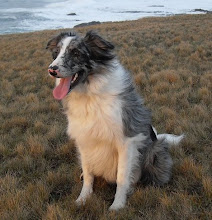
Picture this, if you will, ...
You're knelt or squatting at the bottom of your trench about a metre below ground surface. The trench is miles from civilisation and not even visible from the nearest track. You are working hard when you become aware of a presence above your muddy, intriguing, and challenging environment. You look up above the edge of your trench to see a pair of legs attached to inappropriate footwear, all of which have seen better days and that have suffered from crossing the fields to your location. Before looking further you hear the, predictable, words "
Found any dead bodies yet?", a remark followed by the self-appreciating laughter of the one delivering them...... The visitors/public has arrived!
OK I'm being unfair. The vast majority of visitors to site are polite, interested, intelligent, and enquiring. Even if they arrive ill-informed and have little knowledge, they want to know more of what's going on, they want to "understand". The vast majority that is, unfortunately, it's the other ones that you tend to remember - the idiots and fortunatly the odd bright star...
I remember explaining geophysics to a tourist (an old lady about 80 y.o) visiting our site on Shetland. Trying to explain in very simple terms she stopped me to explain that she was probably the first women to have attended her University and subsequently received a Doctorate in Physics, she understood the principles better than I did, and was exceedingly nice about it.
But my predominant memory of site visitors is of digging in North Yorkshire, in the Vale of Pickering. Standing at the side of the trench with some spare time on my hands I was emptying the buckets of spoil of those working hard below me (as it should be in the natural order of things!). I was explaining to the diggers in the trench that I wanted a dog, preferably a German Shepard, that would be trained to attack on hearing a certain phrase. If you uttered the ubiquitous, oft heard, phrase"
Found any gold yet?" the dog would have your throat out before you could start laughing at your own joke! At this point I looked out across the field of beet, muddy wet and green, to see a couple approaching, no mean feat as we had not advertised our location and nor were we visible from the road. I told the diggers, who could not see them, that we had visitors. The most unpopular member of our disparate group, known to one and all as the "mad axe murderer" (you had to meet him and be there) said "
it'll be mi purunts". I replied enquiring if his mother often wore a denim mini skirt, white high heels, and sported a bee-hive hair-do? ( this was the mid 1990's and predated Amy Winehouse's re-introduction of the bee-hive to the fashion conscious). Axe murderer replied that it was, indeed his "purunts".
Upon reaching the trench the mother looked down and asked (you guessed it..)
"Found any gold yet?", before she could laugh at her own joke the trench erupted into gales of laughter. All we were missing was a German Shepard....



























